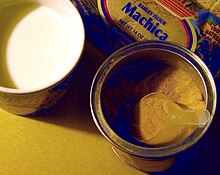Pinol
 Pinol (in tin with scoop) beside a bag of plain máchica and a mug of milk | |
| Country of origin | Central and Latin America |
|---|---|
| Color | Beige or tan to brown |
| Flavor | Anise, cinnamon, clove |
| Ingredients | Máchica, panela, milk or other liquid, spices |
| Related products | Pinole |
Pinol or piñol is a traditional hot beverage of Ecuador, made from máchica (toasted barley flour) and panela (unrefined sugar) mixed with spices and combined with liquid, usually milk. The term pinol may also refer to the dry mix itself.
History
The invention of pinol is attributed to Rafael Emilio Madrid of Salcedo, Ecuador. As the story goes, Madrid was inspired by watching laborers sucking on pieces of panela, and decided to grind panela and mix it with máchica and spices.[1]
The Madrid family's factory, built in the 1950s and located in San Rafael, Ecuador, originally used a millstone to manufacture its pinol mix.[2]
As of 2009, a fourth generation of Madrid's family was still involved in producing pinol mix.[1]
Despite its relatively recent mid-20th-century origin, pinol is considered a traditional food.[1][3]
Ingredients

The mix sold for preparing the pinol beverage consists of finely-ground panela, a form of unrefined cane sugar; máchica, toasted barley flour; and ground spices, usually including anise, cinnamon or ishpingo (a native Andean spice related to cinnamon), cloves and/or peppercorns.[2][4][5] Some preparations of pinol may also include quinoa.[6]
Preparation
Pinol is usually prepared using milk[5][7] or soymilk,[8] but water[1] or fruit juice[6] may also be used. The procedure is similar to that used to make hot chocolate from milk and cocoa powder rather than hot water and a mix.[9]
Other uses
Pinol mix can be used to make fruit smoothies[10] or as an ingredient for custard or other desserts.[6] It is sometimes also eaten with grated cheese, or by itself.[10]
Availability
Ready-to-drink pinol can be purchased at shops and ice cream parlors in Salcedo, where it is consumed by both local residents and tourists.[4]
A number of manufacturers besides the company founded by Rafael Emilio Madrid now produce pinol mix as well.[1] Several brands are exported to other countries to serve Ecuadoran immigrant populations and other customers.[11][12][13]
References
- ^ a b c d e "El Tradicional Pinol" [Traditional Pinol]. La Hora (in Spanish). 10 May 2009. Archived from the original on 3 March 2016. Retrieved 14 October 2015.
- ^ a b "Molido y Procesado" [Milling and Processing]. RicoPinolDeSalcedo.com (in Spanish). Retrieved 14 October 2015.
- ^ "Artesanos de 7 cantones expusieron en Salcedo" [Craftspeople of 7 cantons exhibited in Salcedo]. El Telégrafo (in Spanish). 9 September 2014. Archived from the original on 5 November 2015. Retrieved 14 October 2015.
Otra elaboración tradicional que se degustó fue el pinol, realizado con máchica, panela, canela y clavo de olor, entre otros ingredientes de la zona.
["Another traditional product tasted was pinol, made with máchica, panela, cinnamon and cloves, among other local ingredients."] - ^ a b Rivadeneira, Felipe (2010). "Gastronomia de Salcedo" [Cuisine of Salcedo]. EcuadorinMediato.com (in Spanish). Retrieved 14 October 2015.
- ^ a b Espín de Rivera, Susana; Rivadeneira, Miguel, eds. (2008). La Cebada: Un Cereal Nutritivo: 50 Recetas para Preparar [Barley: A Nutritious Cereal: 50 Recipes to Prepare] (in Spanish). Quito: Instituto Nacional Autónomo de Investigaciones Agropecuarias. p. 47.
El pinol puede servirse como postre batiendo en leche tibia.
["Pinol can be served as dessert beaten into warm milk."] - ^ a b c "Pinol de Quinua" [Pinol with Quinoa] (PDF). DeLaMataALaOlla.WordPress.com (in Spanish). Retrieved 14 October 2015.
- ^ Carrillo Gonzáles, Diego Dimitri (2010). Elaboracion de una bebida láctea saborizada con pinol [Development of a milk drink flavored with pinol] (Thesis) (in Spanish). Universidad Técnica de Ambato. Retrieved 14 October 2015.
- ^ Cazar Proaño, Luis; Cobos Morán, Alex; Acosta Dávila, Sandra (2011). "Diseño del Proceso de una Bebida Líquida a Base de Cereales Ecuatorianos: Soya y Cebada, como Complemento Alternativo en Dietas de Alto Gasto" [Process design of a liquid drink made of Ecuadorian grains: Barley and soya as an alternative supplement in diets high in energy expenditure] (PDF) (in Spanish): 1–6. Retrieved 14 October 2015.
{{cite journal}}: Cite journal requires|journal=(help) - ^ Pinol: Ground Toasted Barley (product label), Guayaquil: La Cholita,
Se puede servir como colada batiendo con leche caliente.
["It can be served like a strained beverage, whipped with hot milk."] - ^ a b "Pinol". RicoPinolDeSalcedo.com (in Spanish). Retrieved 14 October 2015.
- ^ "Products > Food > Flours & Pasta: Page 3". ElCondorChicago.com. Retrieved 14 October 2015.
- ^ "Mercato Latino Americano Espiga Inca Food" [Espiga Latin-American Market: Inca Food]. MLaEspigaIncaFood.com (in Italian). Archived from the original on 16 December 2015. Retrieved 14 October 2015.
- ^ "Pinoleche — Cereal". EcuadorMall.com. Retrieved 14 October 2015.

